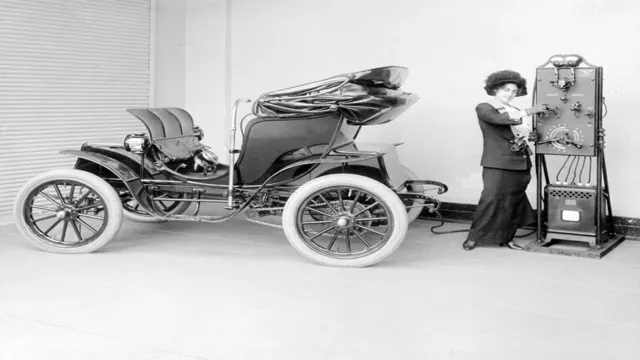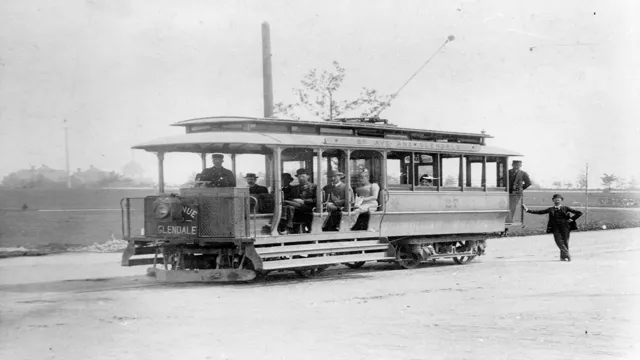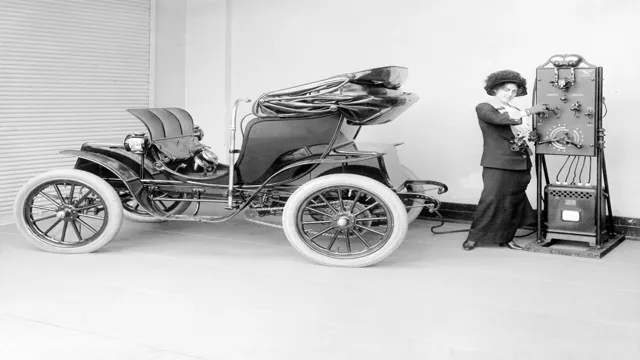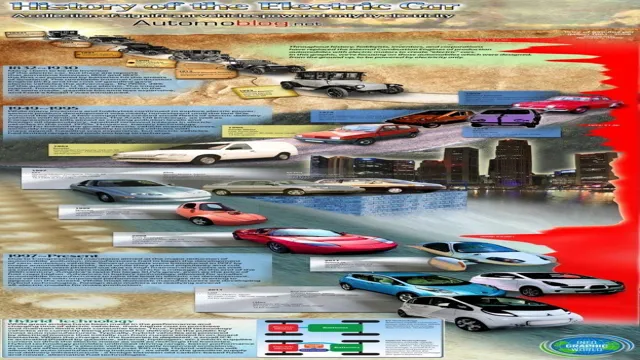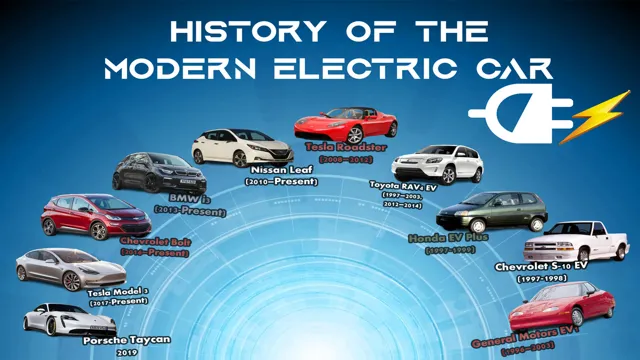Revolutionizing the Wheels: Exploring the Fascinating History of Electric Cars
Electric cars are no longer an elusive concept that only hovers in the distant future. These sleek, noiseless cars have been popping up all over the world, boasting the latest technology and exceptional eco-friendliness. But did you know that electric cars have been around much longer than you might think? In fact, the idea for electric cars dates back over one hundred years! In this blog, we’ll dive into the brief history of electric cars, including their invention, rise, decline, and triumphant comeback.
So buckle up and let’s take a joyride through time!
Early Beginnings
A brief history of electric cars begins in the early 1830s when the first crude electric vehicle was developed. A Scottish inventor, Robert Anderson, created the first electric carriage that used batteries to store power, but it was not until the late 1800s that electric cars started to gain some mainstream popularity. However, the electric car market faced stiff competition from cheaper, more efficient gasoline-powered vehicles that eventually pushed electric cars to the margins.
Despite this, electric vehicles continued to evolve, and by the early 2000s, they were experiencing a revival in popularity thanks to the introduction of new battery technologies and advances in electric motor technology. With a cleaner and more sustainable future in mind, many automakers are investing heavily in electric vehicles, making them more practical and affordable for everyday consumers. It’s clear that the future of electric cars is bright, and we can look forward to seeing new and exciting innovations in this field in the years to come.
1832 – First Electric Car Invented
The invention of the first electric car in 1832 revolutionized the transportation industry. It was created by Scottish inventor Robert Anderson, who used non-rechargeable batteries to power his vehicle. While his creation was only able to travel short distances at low speeds, it paved the way for future innovations in electric transportation.
Anderson’s invention was met with some skepticism at the time, as gasoline-powered cars were not yet popularized and many people were still using horses and carriages. However, his electric car marked a significant milestone in the advancement of sustainable and eco-friendly transportation. Although Anderson’s creation was not as efficient or practical as modern electric vehicles, it demonstrated the potential for electric-powered transportation and laid the foundation for future innovations.
Today, electric cars are becoming more commonplace as we strive for a more sustainable and green future.

Late 1800s – Electric Cars Gained Popularity
During the late 1800s, electric cars began to gain popularity as an alternative mode of transportation. Although the concept of an electric car had been around since the early 1800s, it wasn’t until the late 1800s that people began to take notice. Frenchman Gustave Trouvé, for example, built an electric vehicle in 1881 that was capable of traveling at speeds of up to 12 miles per hour.
However, it wasn’t until the invention of the rechargeable battery in 1865 that electric cars became a viable option. This allowed for longer intervals between charges and helped to make them more practical for everyday use. The electric car seemed like a promising solution to the pollution and noise associated with gasoline-powered cars and by 1900, electric cars made up approximately one-third of all automobiles on the road.
It’s interesting to think about how different our world might be today if the electric car had continued to gain in popularity back then.
Decline of Electric Cars
A brief history of electric cars proves that they have been around for much longer than we initially thought. The first known electric car dates back to 1832, and it wasn’t until the late 1800s that they became more commercially available. In fact, Henry Ford’s Model T was originally designed to run on electricity, but due to advancements in the gasoline-powered combustion engine, it quickly replaced the electric car.
Fast forward to recent years, and we see a resurgence in electric cars due to concerns about air pollution and climate change. However, despite the advancements and popularity of electric cars, there has been a recent decline in sales. This decline may be attributed to various factors such as high price points, lack of charging infrastructure, and range anxiety.
Nonetheless, the potential benefits and advancements in technology should not be overlooked, and we could see a reemergence in electric cars in the near future.
Early 1900s – Advent of Gasoline Cars
The early 1900s saw the introduction of gasoline cars, which ultimately led to the decline of electric cars. Gasoline cars were more powerful and had longer ranges than electric cars, which were limited to short distances. They also had the benefit of being easier to refuel at gas stations, which were becoming more prevalent.
As a result, electric cars became less popular and were eventually phased out by the mid-1920s. It wasn’t until the 1990s that electric cars started to make a comeback due to concerns about the environment and rising gas prices. While the early days of gasoline cars may have spelled the end for electric cars, their current resurgence is a testament to the importance of pushing forward with innovation and progress.
Who knows what exciting advancements in transportation lie ahead?
Mid 1900s – Electric Cars Became Rare
The mid-1900s saw a significant decline in the use of electric cars, and they became quite rare. There were many factors that contributed to this decline, including the decreasing cost of gasoline-powered cars, the lack of charging infrastructure, and better road networks. Additionally, the invention of the electric starter made gasoline-powered cars much easier to use than their electric counterparts.
The development of the interstate highway system also contributed to the decline of electric cars, since gasoline-powered vehicles had a longer range and could travel greater distances. As a result, electric cars became mostly reserved for specialized uses, such as golf carts, forklifts, and other low-speed vehicles. It wasn’t until the turn of the 21st century that we began to see a resurgence in electric vehicles, driven by concerns over climate change and an increasing demand for more sustainable and environmentally-friendly transportation options.
Revival of Electric Cars
Electric cars have been around for over a century, starting with the first electric car patent issued in 188 At the turn of the 20th century, electric vehicles were preferred over gasoline-powered cars due to their quiet engines and lack of pollution. However, the discovery of cheap oil and the invention of the electric starter motor for gasoline vehicles led to the decline of electric cars.
In recent years, there has been a revival of electric cars due to the increase in environmental awareness, government incentives, and improvements in battery technology. Electric cars are now considered the future of transportation as they offer a more sustainable and efficient way of getting around. With more and more major auto manufacturers launching electric cars, it is clear that electric cars are here to stay.
As we move towards a greener and more sustainable future, electric cars will play an increasingly important role in creating a cleaner and healthier planet.
Late 1900s – Increased Concern for Environment
In the late 1900s, people became increasingly concerned about the impact of industrialization on the environment. Smokestacks belching black smoke into the air and oil spills polluting rivers and oceans were everyday occurrences. It was clear that something needed to be done to reduce the damage being done to the planet, and one solution that was looked to was the revival of electric cars.
These vehicles, which had been around since the early 1900s, were powered by rechargeable batteries instead of gasoline and emitted no harmful pollutants into the air. While they had fallen out of favor due to the rise of the gasoline-powered engine, they were seen as a promising solution for reducing our reliance on fossil fuels. Today, electric cars have become much more popular as advances in technology have made them more practical and affordable for everyday consumers.
With their quiet, efficient performance and zero emissions, they are a clear example of how innovation can be used to address some of the most pressing issues of our time.
Late 1990s – Modern Electric Cars Developed
The late 1990s saw a revival of electric cars, as modern technology made it possible to develop more practical and efficient models. The rising concerns about climate change and environmental pollution, along with the increase in oil prices, brought electric cars to the forefront once again. This led to the development of new battery technologies that could provide longer driving ranges and faster charging times.
The entry of new players, such as Tesla, into the electric car market also helped to push for more innovation, competition, and consumer demand. With all these factors coming into play, it was just a matter of time before electric cars became a viable option for the mainstream market. Today, the use of electric cars is growing rapidly, as more people recognize the benefits of driving zero-emission vehicles that are efficient, cost-effective, and stylish.
The future of the auto industry is undoubtedly electric, and it’s fascinating to see how far we’ve come since the early days of the electric car.
Current State of Electric Cars
A brief history of electric cars is essential to understand the current state of these vehicles. In the late 1800s, electric cars were popular as city vehicles due to their quiet and clean operation. However, the invention of the gasoline-powered engine soon made them less popular, and manufacturers shifted their focus towards gas-powered cars.
Fast forward to the 21st century, and the need for environmentally friendly vehicles has brought the electric car back into the spotlight. Today, electric cars range from compact hatchbacks to high-end sports cars, with technology continuing to improve with each passing year. With more and more countries implementing laws to reduce emissions and improve air quality, electric cars are poised to play a significant role in the future of transportation.
Advancements in Battery Technology and Range
Electric cars have come a long way in terms of technology and performance. However, one major concern that still remains among car buyers is the range limitation of electric vehicles. The range of a typical EV is around 150-200 miles on a full charge, which is not enough for long-distance travel without taking frequent breaks to recharge.
To tackle this issue, automakers are continuously working on improving battery technology. The latest advancements in battery technology have helped to increase the range of electric cars significantly. For instance, Tesla’s Model S Long Range Plus has a range of over 402 miles, which is a massive improvement from its previous models.
Additionally, solid-state batteries are being researched and developed, which offers higher energy density, longer lifespan, and improved safety. With such advancements, the range of electric cars is set to get better, making them a more viable option for long-distance travel.
Government Incentives and Growing Market Share
The current state of electric cars is promising, with growing market share and government incentives driving the industry forward. With concerns about the environment and carbon emissions, more and more consumers are looking for eco-friendly options, and electric cars answer this call. Incentives such as tax credits, rebates, and subsidies make electric cars more affordable, and as more companies enter the market, competition is driving down costs even further.
The result is a burst of interest and investment in electric vehicles, with sales growing steadily each year and projections anticipating continued growth in the future. Just like a seedling, the electric car market is beginning to take root, and with ongoing support and innovation, it has the potential to bloom into something truly remarkable.
Conclusion
In conclusion, the brief history of electric cars has been a bumpy ride, from their humble beginnings in the 19th century to the present day. While they faced numerous obstacles and setbacks, such as the popularity and convenience of fossil fuel-powered vehicles, advancements in technology have propelled electric cars back into the limelight. As society continues to prioritize environmentally-friendly options, we can expect the demand for electric cars to rise.
So the next time you’re cruising down the highway in your electric vehicle, remember the long and winding road it took to get there.”
FAQs
When was the first electric car invented?
The first electric car was invented in the 1830s by Scottish inventor Robert Anderson.
What was the range of the first electric car?
The first electric car had a range of around 50 miles on a single charge.
When did electric cars become popular in the United States?
Electric cars became popular in the United States in the early 1900s, when they made up around one third of all cars on the road.
What caused the decline of electric cars in the early 20th century?
The decline of electric cars in the early 20th century was due to advancements in gasoline engine technology, cheaper gasoline prices, and the development of the interstate highway system.
When did electric cars start to make a comeback?
Electric cars started to make a comeback in the 1990s, with the introduction of the General Motors EV1 and the Toyota Prius.
